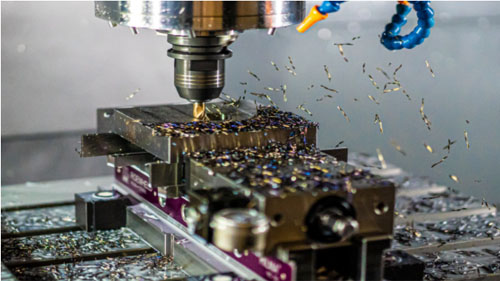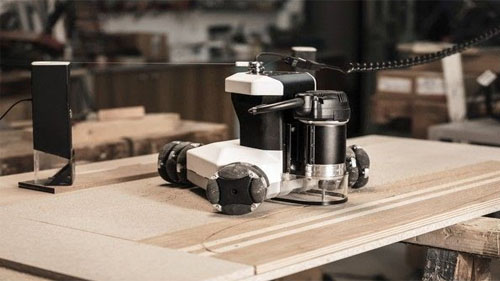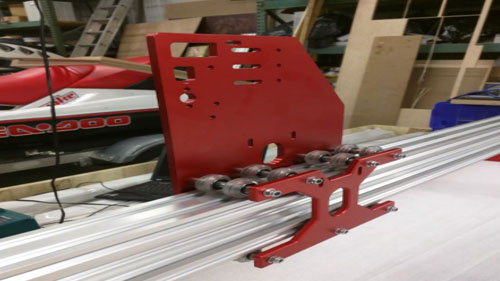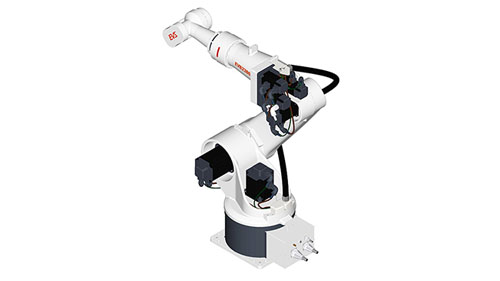
Source: Unsplash
The importance of automated manufacturing cannot be understated, it has transformed the way industries handle their businesses, and with that, more production and profits have become the order of the day. As time progresses, we are gradually entering an era where every single part of manufacturing will be fully automated, and one of the technologies that are at the forefront of this revolution is CNC machines.
We are going to explore CNC machining, what it entails, how the related robots operate, the types that exist, the benefits and reasons for incorporating them into the manufacturing process, and the things one has to consider when choosing a CNC machine. If you have been thinking of fully automating your plant, then stick around to the end and learn a thing or two that will transform your enterprise.
Table of Contents
What is CNC Robotics?

Source: Pinterest
A CNC robot is an advanced robot that is designed solely for the purpose of machining, and it handles its business by following a programmed protocol on its own without any input from an operator. In a nutshell, CNC robotics are independent machines that are advanced to the point where they do their own work without any assistance from a human operator.
Although CNC machining has only begun to pick up pace in the last decade or so, the principle behind it dates back to 1804 where it was brought to life by a Frenchman called Joseph Marie Jacquard, who developed the first card punching machine for his weaving machine.
The first CNC was run by a series of binary codes that only commanded it to punch holes into a card, and with time, it was developed further to be used for textile industries around the world. The technology underwent further improvements about 100 years later when John Parson came up with an automated way for producing aircraft propellers in huge volumes through coding on metal punched cards.
The machine was later found out to be very expensive, and this led to Parson losing his job. His improvements may have been too expensive back then, but with time, more tweaking was added, leading to this modern-day era where CNC robotics are found in every manufacturing industry around the world.
The Importance of CNC Machine in Manufacturing
CNC machining has transformed the manufacturing world without a doubt, and the effects of that can be seen on a daily basis. Manufacturing has become faster, goods have attained better quality, and they are a number of other improvements that have come into effect in the manufacturing space. The following are some of the reasons why CNC Machines are vital in manufacturing.
Fast Production
In the past, a simple broken piece of a machine or the absence of an individual with the skills needed to run a particular machine was enough to slow or even halt the production process. But with CNC robots, that’s no longer an issue. Rather than wait for months for repairs to be made, a missing or broken part can be repaired within hours and days at most, with operations resumed immediately. This ensures that nothing much is lost and orders are met at all times. Once you have set up CNC machining in your factory, make sure you have enough warehousing storage for the goods that will be produced, as you may find yourself in trouble if you can’t keep up with the production speeds.
Reliability
You can always depend on CNC robots to come through with the work as they are designed to handle their work without any supervision. All you need is to set the program how you want it to run and hit the on button. This gives people the chance to concentrate their efforts on other processes, and this further improves the quality of the products at the end of the day. CNC machines rarely break down even when pushed to their limit. This is something that cannot be achieved if human workers are in the equation as they tend to get tired, and once fatigue sets in, precision wavers and the quality of the end products drop down.
No Need for Expertise
Work that used to require years of experience for an individual to be able to handle with minimum flaws can now be handled quickly from the moment the CNC machine is installed with better accuracy. Having to train people to handle one part of the production process can be very expensive, and there’s never any guarantee that they’d stick around for long for the company to recoup their investments. This used to put manufacturing enterprises in a very tight spot. However, with CNC machining, all that’s needed is a functioning program, and the rest is left to the CNC robots.
Cost-Effective
With less human workforce that used to gobble up the profits in the form of salaries, manufacturing plants are now able to save a lot of money by investing in CNC machines that can work for long without breaking down or getting tired. Although their initial costs are very high, once they are set up and running, the work they put in can recoup the initial investment within months, making them a better investment in the long run. The money that companies save in the process can then be reinvested into the company making more improvements that increase production and the quality of the end products.
Safer
Factory accidents are no longer as common as they used to be in the past, thanks to a reduced human workforce. CNC robots are given more space to operate, and they are usually in strategic places that are far from people. With limited interactions between man and machine, the chances of accidents happening are almost reduced to nil, and this has made working safer while reducing the costs that go into compensating injured workers. When dealing with processes like making construction materials, welding, metal cutting, and other high intensive, you can be exposed to heat and loud noises, which can lead to health complications, CNC robots, on the other hand, are immune to such things and can be used without any reservations.
Increased Quality and Affordability
One of the direct advantages of CNC machines, as already mentioned, is fast production that increases supply. Once the supply outstrips the demand, things become cheaper, and this is to the benefit of the consumers. On top of all that, the increased production doesn’t compromise the quality of the products in any way; therefore, people still get the same level of products as before but at reduced prices, and this further boosts purchasing habits, which in turn increases profits to the manufacturer.
Types of CNC Machines

Source: Pinterest
CNC machines come in many shapes, sizes, and functionality, each with a unique design that makes it perfect for the roles it is assigned to. To better understand how they work, it is important that we know the types that exist. On a broader scale, CNC machines can be grouped into three categories outlined below.
By Function
CNC machines are built for a number of functions in different segments of the production process, and based on that; they come in the following types.
Milling Machines: These deal with the loading of raw materials into machines, following a programmed script to make cuts that are precise and identical. They pay attention to the depth, the angle of cuts, and the direction the blades move towards. All these are done by highly specialized robotic arms.
Plasma Cutting: A CNC plasma machine makes use of a tool that is powered by gas to make precise cuts. It is so fast that it can slice up to 500 pieces in 60 seconds with very minimal margins of errors. The only drawback to it is the cost of setting it up since there are many safety protocols like a buffer zone for containing the sparks, good ventilation setups, and flame-resistant doors to keep the rest of the factory safe and avoid accidental fires.
Drilling: This is a CNC machine that spins and moves a drill towards a designated part of an object, most times another piece of metal that requires holes to be bored into. All an operator needs to do is to position the drill, and once that is set, the robotic arm simply executes the commands, and the drilling process begins until the drilling tool is worn out to the point of needing a replacement.
Welding: Welding is considered to be among the most dangerous tasks in the manufacturing process, and that’s why there are special robot CNC machines that exclusively deal with welding. They can withstand the heat, the fumes and gases, and the resulting explosions, something that a human worker can’t handle without sustaining some harm. CNC welding robot machines have positional accuracy, the resilience to handle welding for a very long time without stopping.
Grinding: Grinding is a finishing process that is handled by CNC machines that use their rotary wheels to polish and abrade the surfaces of hard objects until they attain the needed shape. The process requires a high level of accuracy to avoid deforming the product further.
Multitasking: There are CNC machines that are able to be used for multiple operations at the same time without being moved. They are not cheap or easy to operate, but once they are running, they can save you a lot of money as some have the ability to handle the entire process from sorting raw materials all the way to the packaging part.
By the Number of Axes
The movement and operation of a CNC machine depend on the number of axes; they usually range from linear, rotary or can have both of them at the same time. The complexity of the CNC machine is determined by the number of axes that are present, and they come in the following types.
2-Axis: The very first CNC machines were biaxial, and programming them was much easier. They still exist to this day but coming across a 2-Axis CNC robotic arm is hard.
3-Axis: A majority of CNC machines in use today are 3-axis robots, and they are widely used in milling, drilling, and other standard processes on the manufacturing floor. They can operate along all three axes.
4-Axis: These are CNC machines that have an extra rotary axis movement on top of the normal three. They are more flexible and a little complicated than the rest.
5-Axis: These are CNC machines that have three perpendiculars and two rotary axis movements. They are the most versatile of CNC machines as they can be used to conduct different operations at the same time.
By Automation Level and Accuracy Grade
Not all CNC robots are built the same. Some come with more sophisticated setups than others, and they are able to do more when it comes to functionalities. This is what is referred to as the automation level. Some simple CNC machines can only handle the loading and unloading of materials, while more advanced ones can go as far as running their own programs and controlling other robots in the process.
In terms of accuracy levels, CNC machines can be graded as normal for simple machines that handle simple tasks. High-accuracy grade, precision grade, super-precision grade, and ultra-precision grade. Their abilities get refined the higher you go.
Things to Consider When Choosing a CNC Robot Arm

Purchasing a robot is a significant investment that cannot be done on a whim since they are not cheap. When you decide to automate your manufacturing plant with the best CNC robots in the market, the following are some of the factors you have to pay close attention to.
Application
What are the things that you want the robot to handle? You must have a purpose and a need that requires the services of a CNC robot. Is it the heavy lifting in the loading area? Is it a hostile environment involving welding processes? Do you need a high-precision robot, or are you on the lookout for a super-fast robot that will increase your production? All these are questions that will help you narrow down to the right machine.
Integration
The CNC machines must have the ability to integrate with other machines and manufacturing processes that are already in place at the time of purchase. It wouldn’t make any financial sense to get robots that will disrupt the manufacturing process instead of making it more efficient. Always makes sure they can be integrated easily and the operators on-site can be able to figure them out quickly.
Ease of Programming
The programming has to be user-friendly because, at the end of the day, it will require human involvement. If the programming is too complicated for your technicians, then this could add to the cost of operations as it will require you to rely on the robot manufacturers to get things running. Roping in a third-party entity into your business has never been a good idea. Get machines that are easy to program and configure.
Cost of Support
Support is not cheap and depending on where you source your CNC machines; you could either be hit by huge bills in the setup process or get a seamless transition from the human-based workforce to automated production. Some CNC machine suppliers usually provide all the support one needs as an incentive to buying their products. This is much cheaper compared to being left to fend for yourself. Only get your CNC machines from a supplier who’s more vested in your success than in profits.
Conclusion
CNC machines are part and parcel of manufacturing, and anyone who is yet to automate their business is losing out on a lot. It is only a matter of time before everyone embraces them on every level of production, and as technology advances, even human operators will be rendered obsolete very soon. For more information on robotics, their costs, and how you can operate them, check out our website at your earliest convenience.
